I’ve had a lot of gardens over the years. My early gardens consisted of mainly raised garden beds. When I say raised garden beds I’m talking specifically about when the soil sits above the surrounding soil and is enclosed by a solid material like wood, metal, rubber, stone, brick, or plastic.

Raised garden beds have gained a lot of popularity over the last few decades. They look neat and tidy, allow for very loose soil, and are great for areas with poor drainage.
Even though there are some benefits of using raised garden beds, over the years I used them all the negative aspects of them started to outweigh the positives. By year ten I was ready to get rid of them! But thankfully we moved and I didn’t need to revamp my whole garden.
By the way, if you have raised beds and love them, that is ok! I think they do fit in certain situations even though they didn’t work out for me.
I simply want to share my experience over time and my WHY’S for not using them anymore. I share this all in the hope it may help someone just starting out, or starting over, expanding the garden, or even looking for some new ideas.
Here are the reasons I stopped using raised garden beds:
#1 Cost
If you use raised beds, it takes some upfront investment. It may not be a big deal for a small 4x4ft garden but if your garden is large, the costs are staggering! If I am remembering right, Cam and I spent almost $1000 on cedar lumber for our large garden, it was 3000 square feet at the time.
I chose cedar for its versatility in being able to cut to the size I wanted plus the longevity. I had used untreated wood 3 years prior to save money and it rotted out completely so I opted for a material that was more expensive but would last longer.
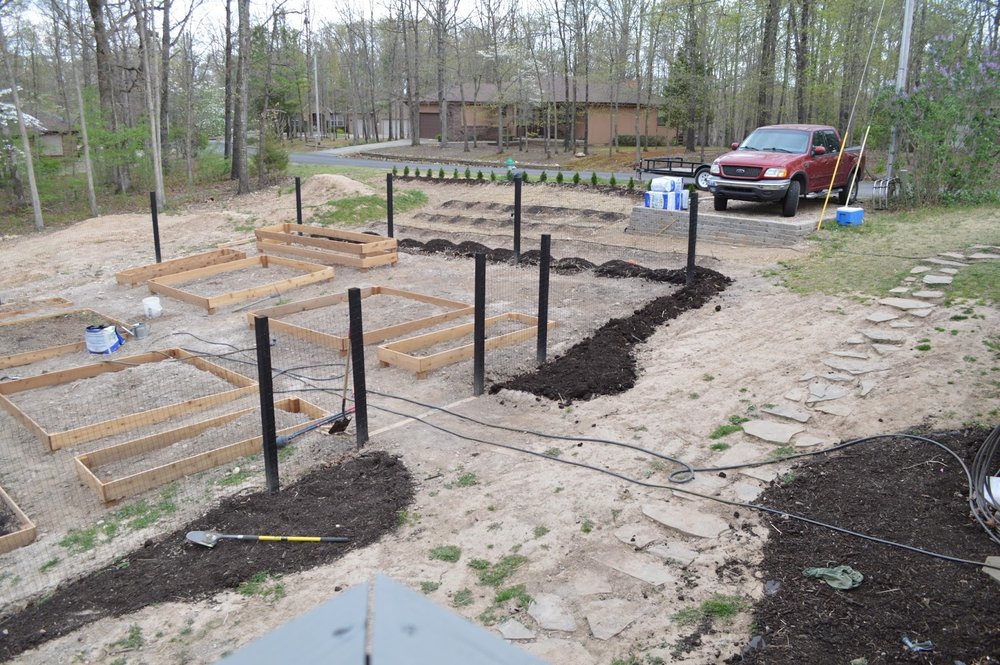
Not only do you need to invest in whatever structure you use to keep it raised, you’ll need to purchase soil and amendments to fill it. How much you need depends on how high you are raising the soil to be.
While there are options to make and fill them cheaper like using recycled materials, with my large scale garden it would have taken so much time to procure those things it didn’t make sense for me personally.
#2 Constantly adding soil, compost, and other things to keep it filled.
Using things like shredded leaves, straw, logs, sticks, etc. help to fill a raised bed on a budget. They are great for adding organic matter too. However, over time those organic materials break down and after a couple seasons you’ll be wondering where all your soil went!
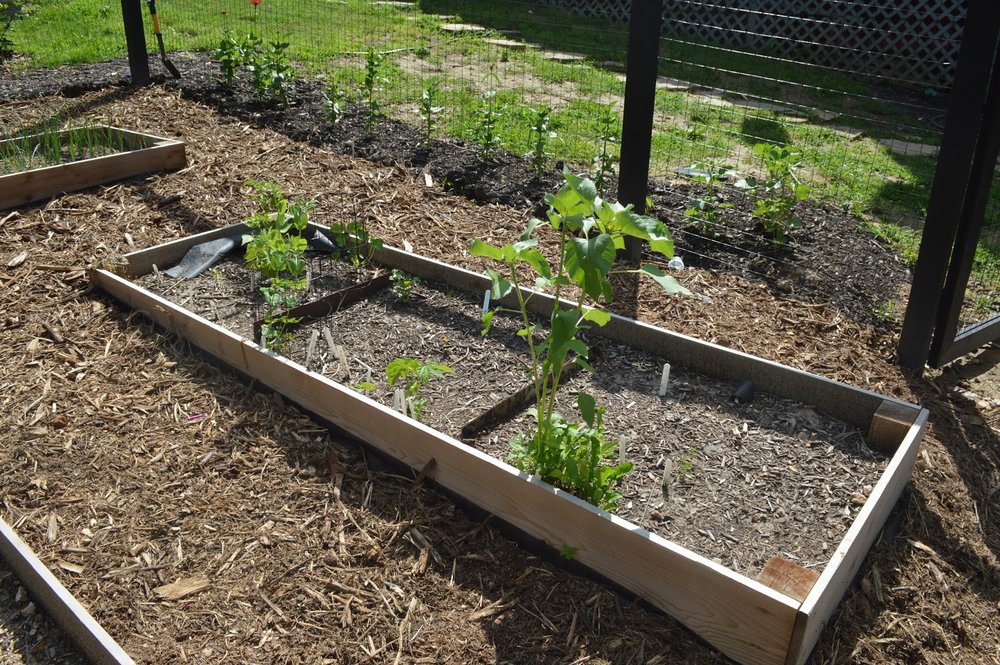
I felt like I was constantly topping off my garden beds with different materials. Between the soil breaking down and me occasionally pulling out roots from spent plants, I had to add several inches of soil and compost every year. Do this across 16 raised garden beds and it really takes a lot of material.
#3 Being Stuck with your Design for what feels like FOREVER
I learned so much every year I gardened. One thing that took me several years to figure out was how I wanted my garden design to be. But before I really worked out the kinks I had already put up all my raised garden beds.
After spending lots of money initially putting them up, I eventually decided my design was flawed on so many levels. And believe it or not this was my THIRD garden! You would think I would have learned by that time, but no, sadly.
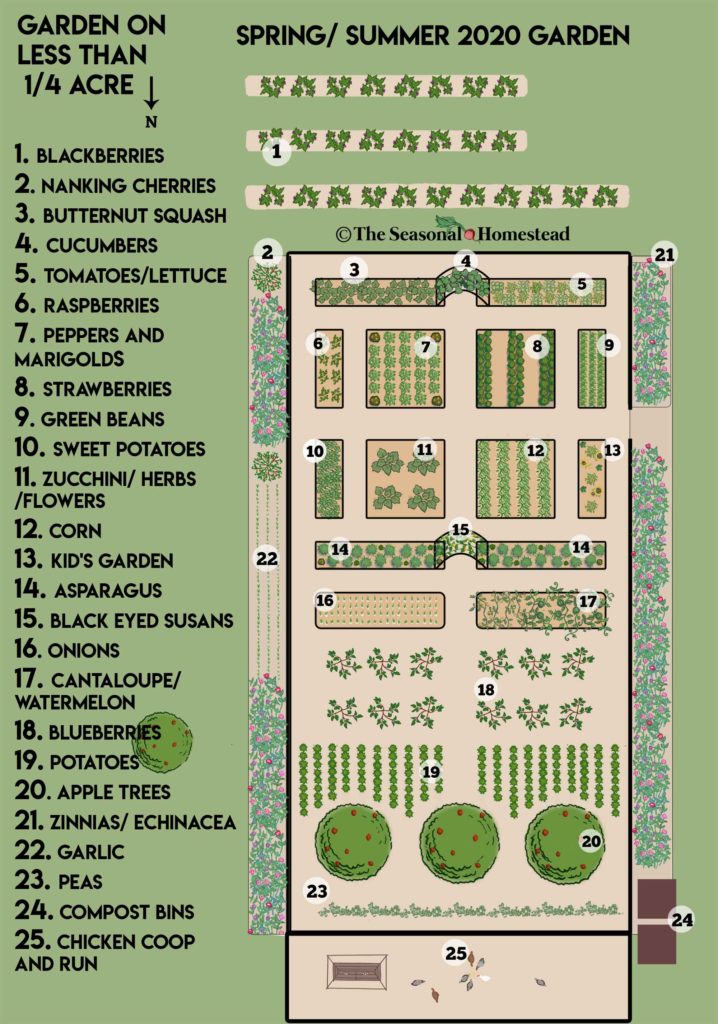
After I put up my garden beds was when I started my goal of growing a year’s supply of food.
All the sudden my garden went from a hobby to more of a serious undertaking and I wanted to utilize every inch! But alas, my garden beds were all already set into place. Obviously, it’s not really forever that I was stuck with the design but the work and money it would have taken to move them was so much.
#4 Not being able to Fully Utilize Time Saving Tools
Using garden tools in raised beds sometimes works but sometimes just doesn’t. When I think about all the tools I utilize now to save time, not many of them would work in a raised bed situation without being awkward or having undesirable results.
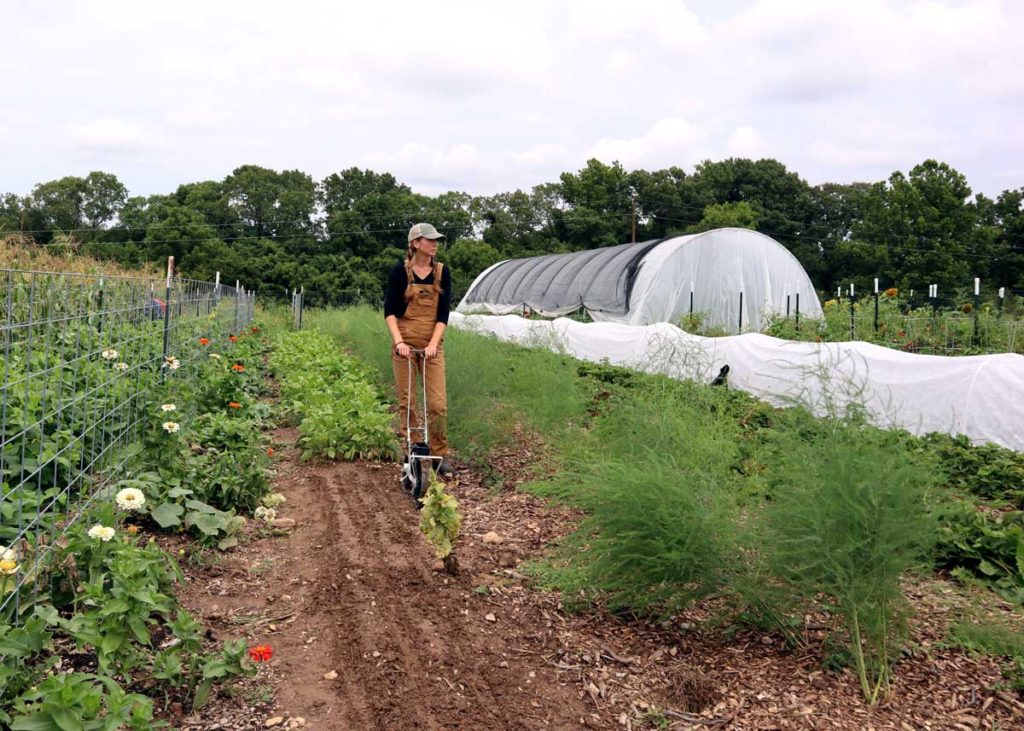
With my large scale garden I rely heavily on using an Earthway and Jang seeder to save time. I just don’t see it working so well in a raised bed because it would hit edges and not be able to utilize the full space.
My wheel hoe, in addition to the tool I use to space out plants, and even the broad fork would all be functional but cumbersome in a raised bed.
#5 Irrigation was complicated
If you plan on using soaker hoses or drip irrigation then it can be a complicated ordeal to set up irrigation that works.
The thing I learned is that water doesn’t flow evenly when it’s fighting against gravity. I didn’t have the best set up for watering because I couldn’t figure it out! I have a friend who is smart and did set it up well for raised beds (you can read about that HERE). And it can totally be done!
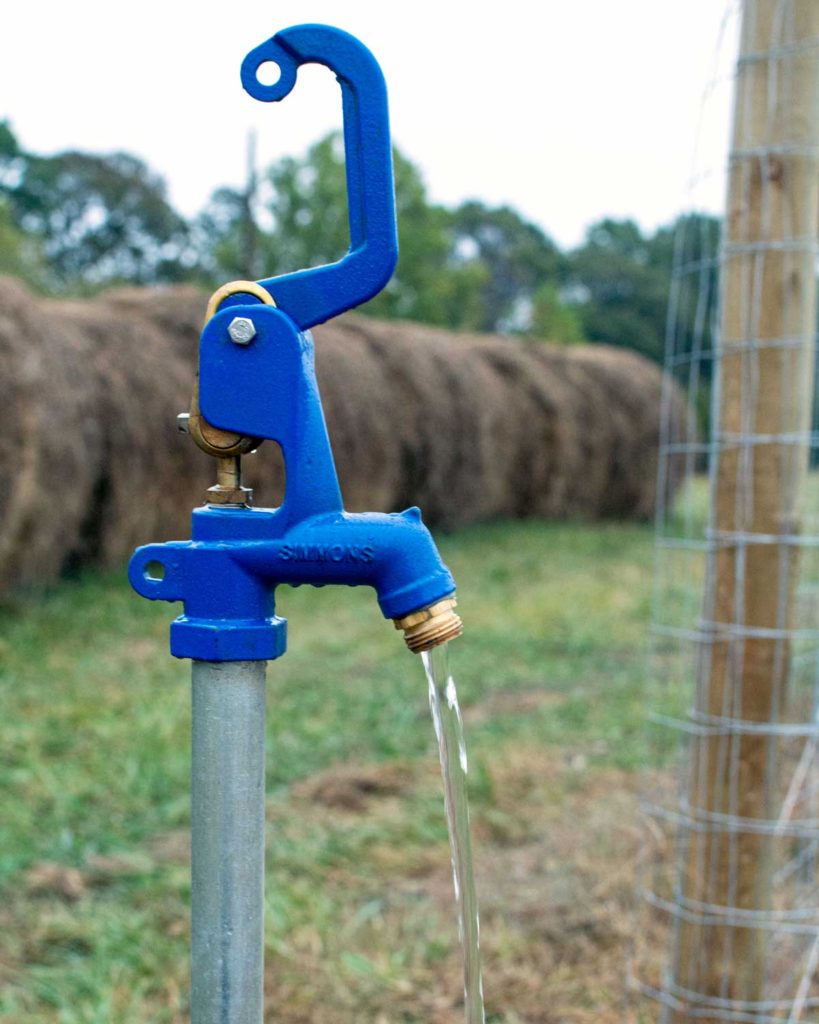
In my set up, I had water hoses going down one bed, strung across the walking area, then up another, and so on. The result was the water pooled right where I didn’t want it to go in between the raised beds because those were the lower areas. Totally a user error but it was frustrating.
#6 Creeping weeds are hard to eliminate
Any weeds that you didn’t eradicate completely prior to building your raised beds are hard to get rid of. This was the case with our very first raised beds and putting them on a lawn that had a large amount of bermuda grass in it.
We cut out the sod and added plenty of cardboard, then filled the raised beds with soil.
The bermuda grass was relentless. It slowly crept under the wood into the soft soil of my raised beds then popped out the top. The wood structure in the way made it really difficult to get out fully.
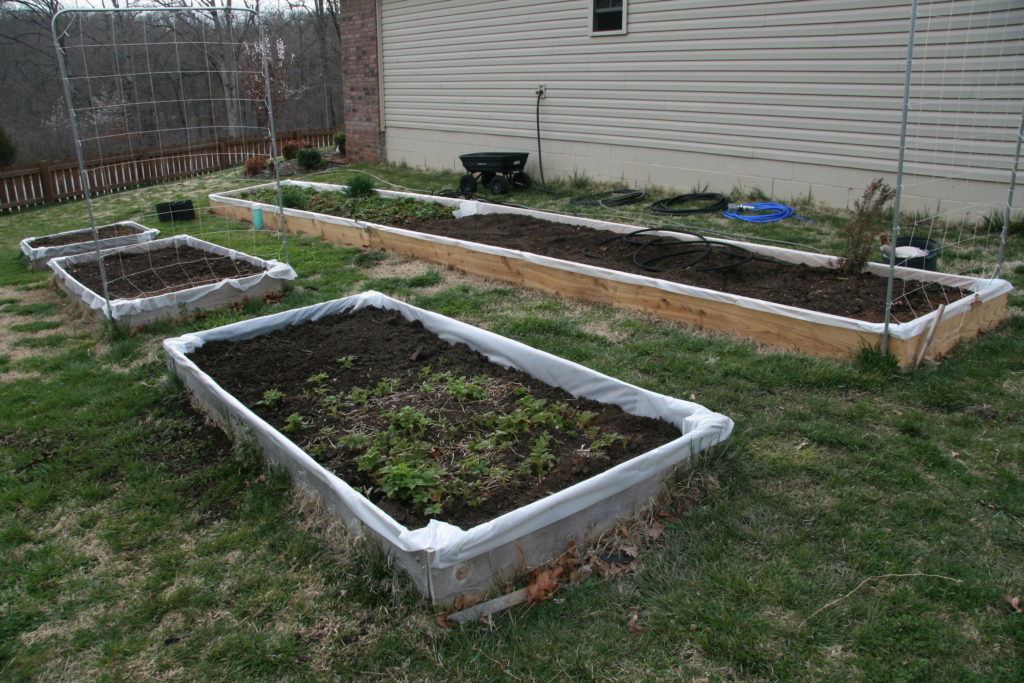
Eventually, I removed the majority of the soil, lined every raised bed with plastic along the sides and bottom to try to keep it from creeping. But it was a fruitless cause. The plastic shredded along the top from the UV rays and along the base it was no match for the bermuda grass. It came through anyway.
It would have been much easier to get rid of the grass if I had no barriers on each garden bed.
For all the reasons mentioned above and most of them stemming back to having a very large garden, I stopped using raised garden beds.
What I use now:
What I use now would be termed “mounded rows or mounded beds”. The soil is raised above the surface around it but not to the extreme (at most 3 or 4 inches) and it doesn’t have a surrounding solid material.
It mimics one of the positive things about raised beds and that is it allows for good drainage but I avoid all the negative things I didn’t like when I ditched the wood barriers surrounding the garden beds.
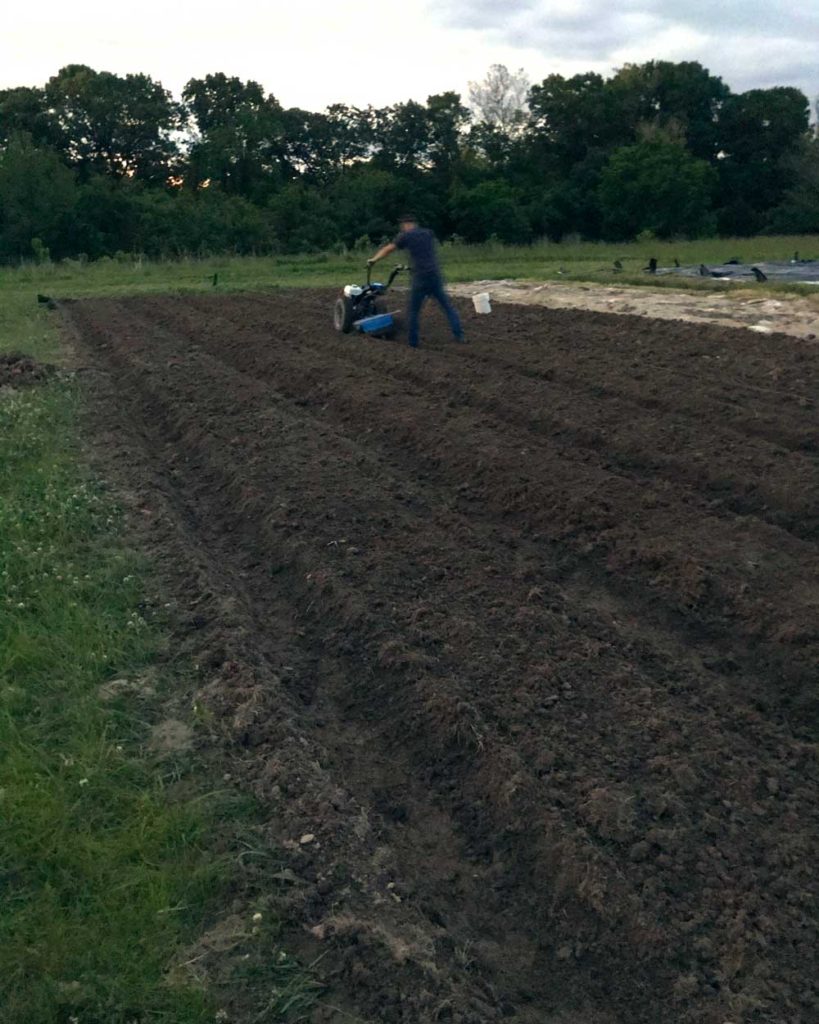
My garden bed size is 30 inches wide and pathway size is 24 inches wide. Initially we did 18 inch pathways but Cam said his feet were too big to walk through it (haha!!) so I made the new area of the garden have larger pathways. I didn’t want any excuse for him to not be able to help in the garden 🙂
I like the 30 inch size garden beds for several reasons. There are tools made specifically for this size garden bed which saves time because you only need to do one pass down a garden bed. It is also more ergonomically friendly, you can reach across it easily and jump over beds easily.
I added some peat moss, compost, and sand initially when I formed the garden beds but in the new areas I left out the sand and peat moss and didn’t notice a huge difference. We do add plenty of compost and use cover crops so there is some investment into the soil but it’s not nearly as expensive as it would have been had I done raised garden beds.
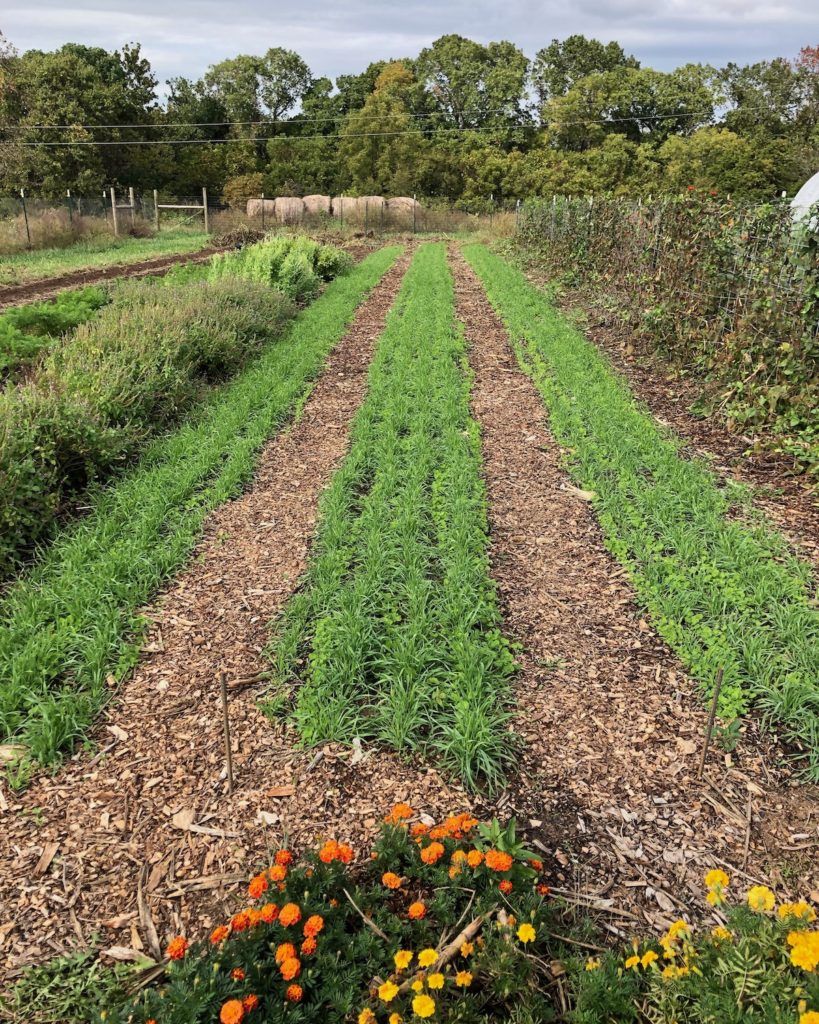
And just for reference, my current garden size is about 14,000 square feet.
Conclusion
Raised garden beds have a lot of hype around them. I hope my reasons why we stopped using them gives you some perspective to help you make the choice that is best for you and your own garden.
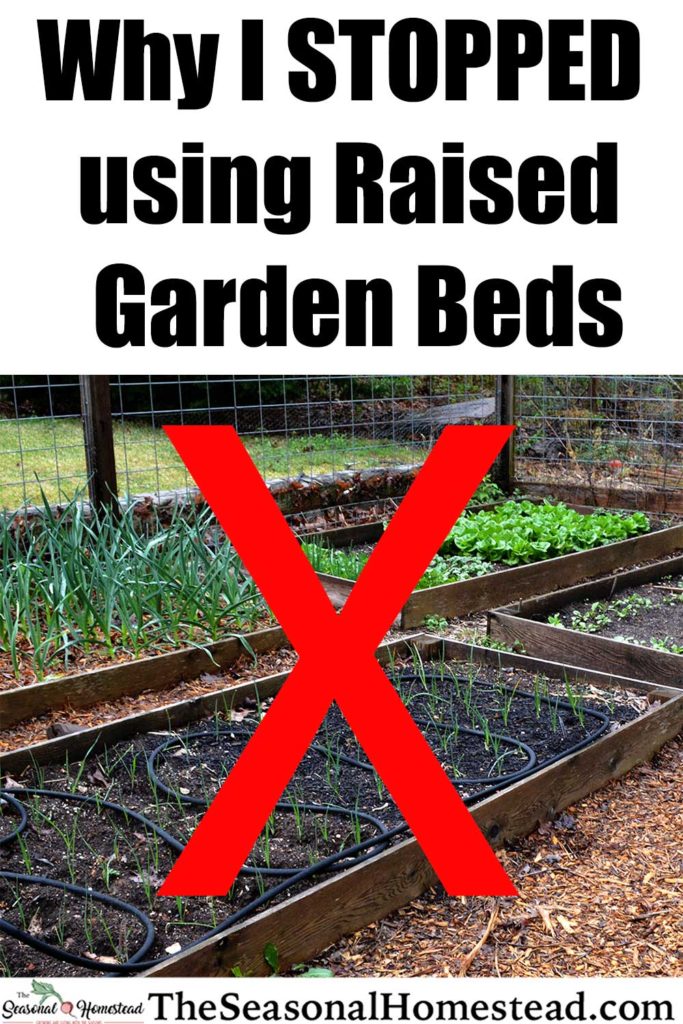

29 comments
I appreciate this as I am preparing my first backyard garden. I live in a small farming community, in a residential neighborhood, and am starting small. I was debating between raised garden beds (wood is so pricey, sadly!) or just tilling up my space I plan to do the garden and adding in good soil and compost and planting directly into the ground.
Do you have any other tips, suggestions?
Thank you SO much for your blog and youtube channel. it’s truly delightful! I have learned SO much from you and your family.
That sounds great Laura. My only other tip if your doing garden beds in the ground is to use string lines when forming them to make everything straight. I really appreciate the kind words!
Hey.. I have 12 large raised beds and I will try to take them down this year. Main reasons are they are rotting and the snails love to next near them and I hope it will make them find other places to make love LOL.. and babies tons of them.. So thanks for the pep talk about it..
Haha! You’re welcome!
Thanks for this very interesting article, I have a large vegetable garden with mounded beds under drip irrigation (I live in Zambia and am fortunate enough to be able to grow veggies all year round) I had been debating putting raised beds in as I thought they looked much neater. So glad I found this article before I went and spent a fortune!
I’m glad it added some insight!
Hi! Very interesting! Your garden is beautiful! I love the food for a year plan! We sadly had to move to a VERY small lot for now so I built four small but taller boxes and alternate things. Hopefully we will be able to move to larger place but we are in central FL , wouldn’t I have to have a bunch of dirt brought in anyway? Dirt here isn’t great. Thanks for your blog🥰
Great post. Your dimensions for the garden beds and paths are helpful! I’m planning my garden now and also decided on a bed size is 30 inches wide and pathway size is 24 inches wide. Seeing photos of your garden helps so much.
Thank you! I’m so glad it was helpful.
I agree with most of your reasons, but I still like raised gardens mainly because I can 100% control what goes in them and, most importantly, the soil never gets compacted like a typical garden. Very few weeds and the weeds I get are easy to pick. I also find the height advantage of raised beds makes harvesting much easier. There is an upfront cost certainly, but I feel the advantages, at least for me, outweigh the disadvantages.
That’s great! It’s important to do what works for you and what you feel is best.
We are starting our garden this year on our new 80 acre homestead. The land was pasture/weeds. I’ve dedicated 1/2 acre to the garden and small orchard. I like your crop rotation diagram I also found on your site. Do you have a drawn plan layout of your now larger garden? I was thinking of doing 5 large garden areas, each about 3,000 square feet to rotate like your crop rotation suggestion. In my previous small in-town backyard I only had a few raised beds. I’m not used to doing a garden right on the ground! Your pictures were very helpful. I’m going to try your suggestion of 30 in. rows and 24 in. between for walking. I found your diagram of your previous smaller garden, but not your new one?…
I am planning on getting an official garden plan up on here soon. Hopefully in the next few weeks! For now I have a rough draft that can be found here https://www.theseasonalhomestead.com/the-weekly-digs-146/ We have one garden that is 100×100 ft of garden space and we planned on expanding to another 100 x 100 ft space but didn’t make it that far. Our second garden area is 40 x 100 ft right now.
What method are you using now for watering your larger garden?
If you can believe it, I’ve hand watered the past few years. I’m hoping to get irrigation set up this year. It will be drip irrigation.
Thank you so much for providing the planting chart! I’m going to add dates to my planner so I can actually get a garden going this year. We do raised beds because our ground isn’t good. It is frustrating having to add back to them but we have horses and pigs so it’s just a matter of moving the material to them. I usually buy a couple bags of raised garden bed soil just so it’s not as compact along with some mulch. I’m planning on mounds on an expanded area though once we get our septic done I figured that will be a good time to get it set up when the grounds disturbed anyway. I’m wanting to do corn, beans and squash outside of the garden beds. We live on a hill so I think mounds would help with erosion. What do you used to set up the mounds?
We set up the mounds using a BCS tractor and rotary plow. It made it easier for a large garden. It could be done by hand but would take a very long time.
Do you have any barrier between your mounded beds and the ground? I was reading about the grass infiltrating your raised beds and was wondering how you’re avoiding that issue. Thanks, and keep up the great articles!!
Yes, we use ground cover all around the edges. Here is what I buy (affiliate link) https://www.farmersfriend.com/p/ground-cover-no-holes?Roll%20Size=4-ft%20%C3%97%20300-ft&rid=tsh
Any suggestions on growing entirely in my greenhouse? I usually start in there and then transplant out of greenhouse.
I plan on zucchini, tomatoes and peppers. Ty
Hi Marie, I need more specifics on what you mean, I’m a little confused on what information you’re seeking. Do you have raised beds in the greenhouse or an area to plant in the ground? Are you wanting to keep the plants in there for the duration of the growing period?
How do you use the ground cover? Is it to be placed between the planted areas as a base for a path or actually used under the planted area? Thanks
Love all your ideas! Thank you.
Do you have any special tips on critter control?
We are inundated with gophers, and moles.
Again, Thank you.
Fencing! Trench around your garden perimeter and bury it deep (depends on your soil but likely 18 inches to two feet) under ground and make sure it’s small enough they can’t get in. I would use a hardware cloth/mesh.
Your article has been so inspiring. Do you net any of your gardens and if so, how to YOU go about that? I am wondering if netting (to keep rats and grasshoppers out) on beds that aren’t bordered by some frame, maybe doesn’t work so well??
To net all you need is wire hoops and sand bags. Or you can bury edge of the net with soil. I covered some small seedlings with netting after planting without hoops, and buried the edges. It did great and kept the bugs out. I have an example you can see here: https://youtu.be/1ZAk9PEBFhY?si=GdyecWYrbpi-nv23&t=462
I’m with you on this one. I think raised beds have their place, especially for elderly people to sit on the side so they don’t have to lean over to weed. I also do mounded rows. I sit on a little bathroom stool to weed, and don’t really have to lean over too bad. Another benefit is that when my kids were young, they could see where the rows were, and could play games in the garden, like tag. I change my patterns every year to keep things interesting. My garden doesn’t get over-saturated with too much rain, as it has better drainage than a flat garden. I also believe in rototilling, so I don’t know how you would do that in raised beds. I grow a massive garden, and have seen that most raised bed gardens don’t grow large quantities. We feed a family of 5, and it takes a lot of food! We used to have sheep, so I would use their bedding as mulch and keep tilling it in every year, so the soil is super rich and fluffy, and when rototilled, easy to rake into mounds. Happy gardening!
Thanks for your thoughts Amy!
Great article! Thank you for all the information. My decision boils down to one BIG issue I have at my place…pocket gophers. The raised bed is easy for me to first line with 1/2” metal fencing material on the bottom to keep out these destructive critters!
I may do some some things with direct sowing, though, after reading your article. Ill see how much I end up losing to the gophers 😆.